생후 4~6개월 영아들의 영양, 양호, Nutrition, and parenting for 4~6 month infants
| 생후 4∼6개월 영아들의 영양 |

사진 3-39. 모유수유를 할 때 젖 먹는 아기와 눈을 맞추면서 수유해야 한다.
Copyright ⓒ 2012 John Sangwon Lee, MD., FAAP
1. 모유수유 Breast feeding
- 이 시기 대부분 영아들은 모유만 먹어도 정상적으로 잘 성장 발육할 수 있다.
- 모유만 먹는 영아들은 철분제, 불소와 비타민 A, C, D가 든 종합 비타민제 드롭을 처방에 따라 먹일 수 있다.
- 비타민 A, C, D가 든 종합 비타민제 이외 더 많은 종류의 비타민과 철분, 불소 등이 든 종합 비타민제도 의사의 처방에 따라 먹일 수 있다.
- 일반적으로 철분제를 따로 먹일 필요는 없다.
- 하루에 5∼6번 정도 모유를 먹을 수 있다.
- 밤에 한 번 잠이 들면 아침까지 한 번도 깨지 않고 계속 자고 엄마 아빠와 같이 아침에 일어나는 영아들도 있다.
- 이렇게 많이 잠자는 영아를 일부러 깨워 밤 중 모유수유를 꼭 할 필요가 없다.
- 생후부터 지금까지 모유가 충분히 분비되면 모유 수유만 해도 잘 성장 발육할 수 있다.
- 생후 4개월부터 이유식을 먹이기 시작할 수 있으나, 이 시기에 이유식을 꼭 먹일 필요는 없다.
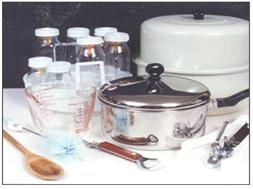
사진 3-40. 인공영양을 먹이는데 필요한 것들.
Copyright ⓒ 2012 John Sangwon Lee, MD., FAAP
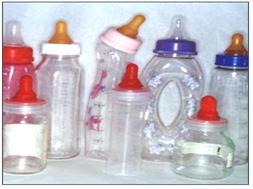
사진 3-41. 인공영양을 먹이는데 필요한 여러 종류의 우유병
Copyright ⓒ 2012 John Sangwon Lee, MD., FAAP
2. 인공영양 Infant Formula
- 인공영양의 종류, 1회분 먹이는 양, 온도, 하루 먹이는 횟수, 먹이는 간격 등을 일률적으로 정할 수 없다.
- 다음에 인공영양을 먹이는 일반적 방법을 설명한다.
- 이 나이의 영아들에게 인공영양을 먹일 때 1회분 150∼240cc(5∼8온스) 정도, 하루 4∼6회 정도 먹인다.(표 3-6, 3-7 참조)
- 영아들에게 필요로 하는 각종 비타민과 미네랄의 종류와 1일 필요 용량이 인공영양 속에 적절히 다 들어 있다.
- 인공영양을 먹는 아기에게 비타민을 따로 더 먹일 필요가 없다.
- 이때부터 우유병과 우유병 젖꼭지를 더 이상 끓여 살균처리를 할 필요가 없다.
3. 물과 수분
- 인공영양 성분의 85%정도가 수분이다.
- 그래서 적절한 양의 인공영양을 먹고 자라는 신생아들이나 영아들에게 물을 따로 더 먹일 필요가 없다.
- 더운 여름철이나 실내가 몹시 덥거나 영아가 땀을 많이 흘리거나 무슨 이유로 탈수가 된 것 같으면 끓여 식힌 맹물이나 보리차 물 등을 숟가락으로 떠먹이든지 젖병으로 가끔 먹여도 된다.

사진 3-42. 여러 종류의 우유병의 젖꼭지.
Copyright ⓒ 2012 John Sangwon Lee, MD., FAAP
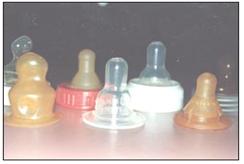
사진 3-43. 여러 종류의 우유병의 젖꼭지.
Copyright ⓒ 2012 John Sangwon Lee, MD., FAAP
4. 이유식
- 인공영양이나 모유를 충분히 먹고 정상적으로 잘 성장 발육하고 있는 4~5개월 된 영아들에게는 이유식을 꼭 먹일 필요가 없다.
- 인공영양이나 모유만 먹고 자주 배고파하거나, 밤에 자다가 배고파서 자주 깨거나, 인공영양이나 모유수유로 영양분과 에너지를 충분히 섭취할 수 없는 것 같거나, 성장 발육이 지연되는 것 같거나, 모유가 충분히 분비되지 않는다고 생각될 때는 의사와 상담한 후 시리얼류 이유식(곡분류 이유식)을 먹이기 시작해도 된다.
- 이유식을 먹이기 시작할 때는 쌀로 만든 곡분류 이유식을 맨 처음 준다.
- 한 숟가락 정도 쌀 시리얼 이유식을 짠 모유나 인공영양과 섞어서 숟가락으로 떠먹일 수 있다.
- 이런 쌀 시리얼류 이유식을 하루 1∼4번 정도, 약 3∼7일간 시험 삼아 먹여보고 그 이유식을 잘 받아먹고 이유식을 먹은 후 잘 소화시키고 설사하지 않고 위장장애가 생기지 않고 알레르기가 생기지 않으면 그 후 계속 먹일 수 있다.
- 쌀 시리얼류 이유식이 아기에게 적절한 이유식이라고 판단이 나면 쌀 시리얼류 이유식 1회분을 점차로 증가해서 계속 먹일 수 있다.
- 사과나 그 외 다른 과일로 만든 과일류 이유식, 호박이나 당근 등으로 만든 채소류 이유식, 과일 주스류 이유식은 될 수 있는 한 생후 6개월 이전에는 먹이는 것을 미 소아청소년과 학회는 권장하지 않는다.
- 과일류 주스나 채소류 주스 이유식은 생후 6개월 이전에는 먹이지 말고 그 이후에도 영아들에게 될 수 있는 한 많이 먹이지 말라고 미 소아청소년과 학회는 권장한다.
- 쇠고기, 양고기, 또는 닭고기 등 육류 이유식 또는 조류 이유식이나 생선류 이유식은 생후 9~10개월부터 먹이기 시작할 수 있다.
- 그 중 한 가지 종류를 선택해서 시험 삼아 조금씩 먹여 보고 아기가 먹기를 좋아하고 잘 소화 시키고 음식물 알레르기 반응이 생기지 않으면 의사의 지시에 따라 육류 이유식을 계속 먹일 수 있다.
- 이유식을 처음 먹일 때는 한 종류의 이유식을 시험 삼아 약 1주 정도 먹여보고 그 이유식을 먹고 문제가 없으면 그 다음에는 두 가지 그 다음에는 세 가지, 또는 그 이상 여러 가지의 이유식 성분이 섞인 종합 이유식을 먹일 수 있다.
- 이유식을 먹고 소화를 잘 시키면 이유식을 하루 1∼4번 정도로 먹일 수 있고 성장 발육의 정도와 먹성에 따라 이유식의 양을 점차로 증가시킨다.
- 이유식을 먹이기 시작할 때 처음부터 “많이 먹으면 좋다”라고 생각해 한꺼번에 너무 많이 먹여서는 안 된다.
- 처음부터 적은 양을 먹이기 시작하고 점점 양을 늘리는 편이 훨씬 좋다.
- 하루 중 어느 때가 이유식을 먹이기에 가장 좋은지 일률적으로 정할 수 없다.
- 엄마 아빠 일상생활 패턴 리듬에 맞춰 모유나 인공영양을 먹인 후 바로 이유식을 먹이든지, 모유나 인공영양을 먹일 시간에 모유나 인공영양을 먹이는 대신 이유식만 주든지, 모유나 인공영양을 먹이기 바로 전에 이유식을 먹이든지, 또는 모유나 인공영양을 먹는 시간 사이사이에 먹일 수 있다.
- 주스류 이유식을 처음 먹일 때 한 번에 한 종류의 주스류 이유식 1회분 15∼30cc 정도를 먹여볼 수 있다.
- 쌀 곡분류 시리얼 이유식이나 육류 이유식을 1회분 테이블스푼 분량(15㏄) 정도를 처음 먹여본다.
- 달걀 전체나 전 우유는 생후 12개월까지 먹이지 말아야 한다.
- 달걀노른자는 생후 6개월부터 먹일 수 있다. 과일 주스류나 과일즙류 등 이유식은 이유 연습용 컵으로 먹이든지 숟가락으로 떠먹이는 것이 좋다.
- 시리얼류 이유식이나 육류 이유식을 우유병에 넣어 먹여서는 안 된다.
- 이유식을 먹일 때 이유식 1회 분이나, 또는 하루 분량을 잘 조절해서 먹여야 한다.
- 이유식을 한 번에 너무 많이 먹이거나 너무 자주 먹이면 소화 장애가 생길 수 있다.
- 영아들에게 이유식을 너무 많이 먹이면 비만해질 수 있다.
- 사실은 영아들이 모유나 인공영양을 충분히 먹으면 생후 6개월 이전 이유식을 조금도 먹지 안 해도 잘 성장 발육할 수 있다.
- 다시 한 번 더 강조하면, 이유식은 시험 삼아 조금씩 먹이기 시작하고 그 총량과 종류를 점점 늘려 먹여야 한다([부모도 반의사가 되어야 한다-소아가정간호백과]-제 4권 모유, 모유수유, 이유-젖을 뗄 때, 이유식 참조).
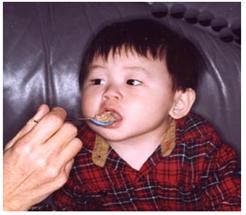
사진 3-44. 이유식은 숟가락이나 컵으로 먹인다.
Copyright ⓒ 2012 John Sangwon Lee, MD., FAAP
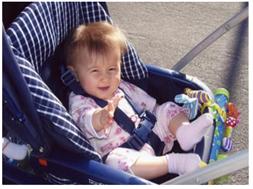
사진 3-45. 승용차를 타고 영유아를 데리고 어디를 갈 때는 국법으로 허가된 안전 의자에 태우고 차를 몬다. 이것은 법이다. Copyright ⓒ 2012 John Sangwon Lee, MD., FAAP
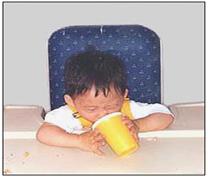
사진 3-48. 이유식은 자신이 연습용 컵으로 먹는다.
Copyright ⓒ 2012 John Sangwon Lee, MD., FAAP
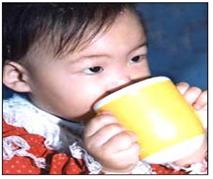
사진 3-49. 이유식은 자신이 연습용 컵으로 먹는다.
Copyright ⓒ 2012 John Sangwon Lee, MD., FAAP

사진 3-50. 이유식을 손으로 먹게 한다.
Copyright ⓒ 2012 John Sangwon Lee, MD ., FAAP
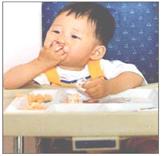
사진 3-51. 이유식을 손으로 먹게 한다.
Copyright ⓒ 2012 John Sangwon Lee, MD., FAAP
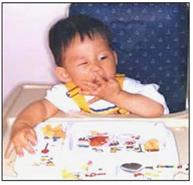
사진 3-52. 이유식을 손으로 먹게 한다.
Copyright ⓒ 2012 John Sangwon Lee, MD., FAAP
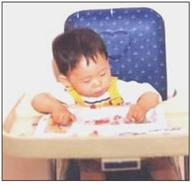
사진 3-53. 이유식을 손으로 먹게 한다.
Copyright ⓒ 2012 John Sangwon Lee, MD., FAAP
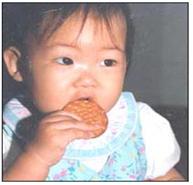
사진 3-54.생후 6개월 이후 이유식 영유아용 과자를 손으로 먹을 수 있다.
Copyright ⓒ 2012 John Sangwon Lee, MD., FAAP

사진 3-55.생후 6개월 이후 이유식 영유아용 과자를 손으로 먹을 수 있다.
Copyright ⓒ 2012 John Sangwon Lee, MD., FAAP
| 생후 4∼6개월 영아들의 양호 |
- 이 시기의 대부분의 영아들은 뒤 쪽에서 앞 쪽으로 엎치기 시작한다.
- 온몸을 스스로 조금씩 움직여서 한 자리에서 다른 자리로 이동할 수 있다.
- 높은 곳에 눕히거나 앉히면 떨어져 낙상하기 쉽다.
- 높은 곳에 영아를 혼자 눕히지 말아야 한다.
- 이 시기 영아들은 손에 닿는 것은 무엇이든지 잡으려고 한다.
- 커피나 국물 등 뜨거운 음식물을 갑자기 채 틀고 엎질러 데지 않도록 특히 주의한다.
- 잡히는 대로 아무 것이나 입 안에 집어넣으려 한다.
- 이물이 기도 속으로 흡인되어 기도 내 이물질로 질식될 수 있다.
- 질식 사고나 소화관 내 이물 사고 등 안전사고가 생기지 않게 영아 손에 닿지 않게 모든 것을 잘 보관한다.
- 승용차를 타고 어디를 갈 때 안전의자에 영아를 앉히고 운전한다.
- 생후 6개월에 정기 건강검진을 해 주고, 3차 DTaP, 3차 불활성 소아마비(IPV), 3차 B형 간염(HepB), 3차 히브(Hib), 3차 로타(RV), 3차 폐렴 연쇄성 구균 감염 예방접종(PCV)의 백신으로 예방 접종받는다.
- 인플루엔자 백신을 의사의 지시에 따라 이제부터 매년마다 예방 접종받는다.
- 로타 바이러스 감염병 백신 Rotrix을 생후 2 개월과 4개월에 접종 받았으면 생우 6개월에 3차 접종을 받을 필요가 없다.
- 그 다음 정기 건강 진찰은 생후 9개월경에 받는다.
|
다음은 “아기의 키와 체중, 성장차트, 키가 안 컸어요”에 관한 인터넷 소아청소년 건강상담 질의응답의 예 입니다. |
Q&A. 아기의 키와 체중, 성장차트, 키가 안 컸어요
Q.
안녕하세요. 초보엄마라 걱정이 많아서 이렇게 글을 올립니다. 우리 아이는 4개월 된 남자 아이거든요.. 태어났을 때 4kg54cm로 났어요. 예정일 보다 2주 늦게 태어났거든요 그리고 계속 잘 자랐어요. 몸무게도 잘 늘고요. 2달 전 예방접종을 하기 위해 병원에 갔을 때는 키가 66~67cm정도였거든요. 며칠 전 접종날짜가 되서 갔었는데 키가 그대로예요. 병원에서는 엄마가 잘못알고 있는 거 아니냐고 어떻게 몸무게는 잘 늘고 있는데 키가 안 컸겠냐고요. 집에 와서 생각을 해봐도 제가 잘못 잰 게 아닌 거 같아서요. 이렇게 글을 올립니다. 지금은 8kg입니다 키는 같고요.
A.
형님
안녕하세요.
좋은 질문을 해 주셔서 감사합니다.
자녀의 나이, 성별, 과거 병력, 가족 병력, 진찰소견, 임상검사 등의 정보를 많이 알수록 답변을 드리는데 도움이 됩니다.
주신 정보를 토대로 해서 답변을 드리겠습니다.
제가 만든 한국 소아 성장차트에 의하면 출생 시 체중은 90퍼센타일 이고 신장은 50퍼센타일 이었고 생후 4개월 체중은 90퍼센타일 신장은 90퍼센타일 입니다.
아기의 키와 몸무게는 평균보다 더 큰 편이고 정상적으로 잘 성장하고 있습니다.
영유아들의 체중은 소변이나 대변을 보기 전후 또는 음식물 섭취 전후에 따라 시시각각으로 조금씩 줄 수 있고 늘 수 있습니다.
같은 날에 잰 체중도 잰 체중기에 따라 체중치가 조금씩 다를 수 있습니다.
또 영유아들의 키를 정확하게 재는 데는 상당히 어려움이 따릅니다.
특히 같은 날 잰 신장치도 들쑥날쑥 조금씩 다를 수 있습니다.
해당 연령 성장 발육, 생후 1개월~6세 아이들의 발육 이정표 참조.
[부모도 반의사가 되어야 한다–소아가정간호백과]-제 14장 소아청소년 내분비선, 유전, 대사이상, 희귀병 –성장차트, 퍼센타일, 성장차트 예 등을 읽어보시기 바랍니다.
아기의 체중 치와 신장 치를 성장차트의 백분위선에 그려보시면 아기의 체중과 신장이 정상적으로 잘 성장하는지 쉽게 알 수 있습니다.
한 번 그려보십시오. 질문이 더 있으면 다시 연락해 주시기 바랍니다. 감사합니다. 이상원 드림
Nutrition, good nutrition, and parenting for 4-6 month infants
Nutrition for infants 4-6 months old

Picture 3-39. When breastfeeding, make sure to make eye contact love with the infant who is breastfeeding. Copyright ⓒ 2012 John Sangwon Lee, MD., FAAP
1. Breastfeeding
• Most infants at this age can grow and develop normally by eating only breast milk.
• Breastfed infants may be given a drop of a multivitamin containing iron, fluoride and vitamins A, C, and D as prescribed.
• In addition to multivitamins containing vitamins A, C, and D, more types of vitamins and multivitamins containing iron and fluoride can also be given according to the doctor’s prescription.
• There is generally no need to take iron supplements separately.
• You can breastfeed 5 to 6 times a day.
• There are infants who fall asleep once at night and sleep without waking up until morning and wake up in the morning with their mothers and fathers.
• Deliberately wake an infant who sleeps so much so they don’t necessarily need to breastfeed at night.
• If enough breast milk is secreted from birth until now, growth and development can be achieved just by breastfeeding.
• You can start feeding baby food from 4 months of age, but it is not necessary to start feeding baby food at this time.

Photo 3-40. What is needed for artificial nutrition? Copyright ⓒ 2012 John Sangwon Lee, MD., FAAP

Photo 3-41. Different types of milk bottles are needed for artificial nutrition. Copyright ⓒ 2012 John Sangwon Lee, MD., FAAP
2. Artificial Nutrition Infant Formula
• The type of artificial nutrition, amount of feeding per serving, temperature, number of feedings per day, feeding interval, etc. cannot be determined uniformly.
• The following describes the general method of feeding artificial nutrition.
• When feeding artificial nutrition to infants of this age, feed 150-240cc (5-8 ounces) at a time, 4-6 times a day (see Tables 3-6 and 3-7).
• The types of vitamins and minerals needed by infants and the daily required dose are all properly contained in artificial nutrition.
• Babies on artificial nutrition do not need additional vitamins.
• From this point on, it is no longer necessary to boil and sterilize the milk bottle and bottle nipple.
3. Water
• About 85% of artificial nutrients are water.
• So there is no need to add water to newborns or infants who are growing up on an adequate amount of artificial nutrition.
• In hot summer, if the room is very hot, the infant sweats a lot, or if you feel dehydrated for some reason, he can drink boiled and cooled freshwater or barley tea with a spoon or feed it occasionally with a baby bottle.

Photo 3-42. The nipple of different types of milk bottles. Copyright ⓒ 2012 John Sangwon Lee, MD., FAAP

Photo 3-43. The nipple of different types of milk bottles. Copyright ⓒ 2012 John Sangwon Lee, MD., FAAP
4. Weaning Baby food
• It is not necessary to feed infants aged 4 to 5 months who are well-developed and fully fed with artificial nutrition or breast milk.
• They are often hungry after eating only artificial nutrition or breast milk, frequently waking up hungry from sleeping at night, not getting enough nutrients and energy through artificial nutrition or breastfeeding, appearing to be stunted in growth and development, or not getting enough breast milk. If you think it is not secreted, after consulting your doctor, you can start feeding cereal-based baby food (grain-type baby food).
• When you start feeding baby food, give them grain-sorted baby food made from rice first. • You can mix a spoonful of rice cereal baby food with milk or artificial nutrition and eat it with a spoon.
• Try feeding these rice cereal types of baby food 1 to 4 times a day, for about 3 to 7 days, and eat and eat the baby food well. can be fed
• If it is determined that the rice cereal type baby food is suitable for the baby, you can continue to feed the rice cereal type baby food by gradually increasing it.
• The American Academy of Pediatrics does not recommend eating fruit-based baby food made from apples or other fruits, vegetable baby food made from pumpkin or carrots, and fruit juice-based baby food before 6 months of age if possible.
• The American Academy of Pediatrics recommends that fruit juices or vegetable juices should not be fed before 6 months of age and that infants should not be fed as much as possible after that.
• Meat baby foods such as beef, lamb, or chicken baby foods or fish baby foods can be started from 9 to 10 months of age.
• Choose one of them, try and feed them little by little. If your baby likes to eat, digests well, and does not have a food allergy, you can continue to feed the meat baby food according to the doctor’s instructions.
• When feeding baby food for the first time, try one type of baby food and feed it for about a week. If there is no problem after eating the baby food, then two, then three, or more various baby food ingredients are mixed. can be fed
• If you eat baby food and digest it well, you can feed baby food 1 to 4 times a day, and gradually increase the amount of baby food according to the degree of growth and development and feeding characteristics.
• When you start feeding baby food, you should not feed too much at once because you think “it is good to eat a lot” from the beginning.
• It is much better to start with a small amount at the beginning and gradually increase the amount.
• There is no one-size-fits-all decision on which time of day is the best time to feed baby food.
• Feed the baby food immediately after breast milk or artificial nutrition is fed in accordance with the rhythm of mother and father daily life patterns, or just before feeding breast milk or artificial nutrition, instead of feeding breast milk or artificial nutrition, just before feeding. It can be fed with baby food, or between feedings with breast milk or artificial nutrition.
• When feeding juice-based baby food for the first time, you can feed about 15-30cc of one type of juice-type baby food at a time.
• Try feeding rice grain-sorted cereal baby food or meat baby food for the first time with about a tablespoon (15cc).
• Whole eggs or whole milk should not be fed until 12 months of age.
• Egg yolk can be fed from 6 months of age. It is better to feed baby food such as fruit juices or fruit juices with a cup or spoon for weaning practice.
• Do not feed cereal or meat baby food in a bottle.
• When feeding baby food, one serving of baby food or one day’s amount should be adjusted well.
• Feeding too much or too often at one time can cause digestive problems.
• Feeding too much baby food to infants can lead to obesity.
• In fact, if infants eat enough breast milk or artificial nutrition, they can grow and develop well even if they do not eat any baby food before 6 months of age.
• To emphasize once again, start feeding baby food little by little as a test and gradually increase the total amount and type of feeding www.drleepediatrics.com – Vol. When weaning, see baby food).

Photo 3-44. Feed baby food with a spoon or cup. Copyright ⓒ 2012 John Sangwon Lee, MD., FAAP

Photo 3-45. When traveling with infants and toddlers in a car, put them in a safety seat approved by national law and drive the car. This is the law. Copyright ⓒ 2012 John Sangwon Lee, MD., FAAP

Picture 3-48. Baby food is eaten from the cup for practice. Copyright ⓒ 2012 John Sangwon Lee, MD., FAAP

Photo 3-49. Baby food is eaten from the cup for practice. Copyright ⓒ 2012 John Sangwon Lee, MD., FAAP

Photo 3-50. Have them eat baby food with their hands. Copyright ⓒ 2012 John Sangwon Lee, MD ., FAAP

Photo 3-51. Have them eat baby food with their hands. Copyright ⓒ 2012 John Sangwon Lee, MD., FAAP

Photo 3-52. Have them eat baby food with their hands. Copyright ⓒ 2012 John Sangwon Lee, MD., FAAP

Photo 3-53. Have them eat baby food with their hands. Copyright ⓒ 2012 John Sangwon Lee, MD., FAAP

Picture 3-54. After 6 months of age, babies can eat sweets with their hands. Copyright ⓒ 2012 John Sangwon Lee, MD., FAAP

Picture 3-55. After 6 months of age, baby food can eat infant cookies with their hands. Copyright ⓒ 2012 John Sangwon Lee, MD., FAAP
Good parenting for infants 4-6 months old
• Most infants at this age begin to lean from the back to the front. • You can move from one place to another by moving your body little by little.
• If you lay down or sit in a high place, it is easy to fall and fall.
• Never lay infants alone on high places.
• At this age, infants try to grab anything they touch.
• Be especially careful not to accidentally stir hot food, such as coffee or broth, and not spill and burn it. • They try to put anything they can get into their mouth.
• Foreign objects can be sucked into the airways and suffocate with foreign objects in the airways.
• Keep everything out of reach of infants to prevent safety accidents such as suffocation or foreign objects in the digestive tract.
• When going anywhere in a car, put the infant in a safety chair and drive.
• Regular health check-ups at 6 months of age, tertiary DTaP, tertiary inactive polio (IPV), tertiary hepatitis B (HepB), tertiary Hib, tertiary rota (RV), tertiary pneumonia Get vaccinated with the Streptococcal Vaccination (PCV) vaccine.
• Get the influenza vaccine every year from now on as directed by your doctor.
• If the rotavirus vaccine Rotarix was vaccinated at 2 months and 4 months of age, the third dose is not necessary at 6 months of age.
• The next regular health checkup is around 9 months of age. The following is an example of an Internet pediatric health consultation Q&A regarding “Baby’s height and weight, growth chart, and he was not tall”.
Q&A. Baby’s height and weight, growth chart, not tall
Q. Good morning. As a new mom, I am so worried, so I am posting this. My child is a 4-month-old boy. When he was born he weighed 4kg54cm. He was born two weeks later than expected and he continued to thrive. He is gaining weight well. When I went to the hospital to get vaccinated two months ago, he was between 66 and 67 cm tall. He went a few days ago for his inoculation date, but he’s the same height. At the hospital, she asked if her mother had misunderstood her, and how could she not have grown taller when she was gaining weight well. Even when I get home and think about it, I don’t think I measured it wrong. I am posting like this. I’m 8kg now and I’m the same height
A.
brother Good morning. Thanks for asking a good question. The more information you know about your child’s age, gender, past medical history, family history, examination findings, and clinical tests, the more helpful it is to give you an answer. We will give you an answer based on the information you provided. According to the Korean child growth chart I made, the weight at birth was 90 percentile and the height was 50 percent, and the weight at 4 months of age was 90 percent and the height was 90 percent. The baby’s height and weight are larger than average and are developing normally. The weight of infants and young children can be reduced or increased little by little each minute before and after urinating or defecating, or before and after food intake.
The weight on the same day may be slightly different depending on the weighing machine. In addition, it is quite difficult to accurately measure the height of infants and young children. In particular, the kidneys measured on the same day may vary slightly. Appropriate age growth and development, see milestones for children aged 1 month to 6 years.
www.drleepediatrics.com- Chapter 14 Children and adolescents Endocrine glands, heredity, metabolic abnormalities, rare diseases – Please read growth charts, percentages, and examples of growth charts. You can easily see if your baby’s weight and height are growing normally by plotting the baby’s weight and height on the percentile line of the growth chart. Try drawing it once. If you have any further questions, please contact us again. Thank you. Lee Sang-won
출처 및 참조문헌
- Nelson Textbook of Pediatrics 22ND Ed
- The Harriet Lane Handbook 22ND Ed
- Growth and development of the children
- www.drleepediatrics.com 제1권 소아청소년 응급 의료
- www.drleepediatrics.com 제2권 소아청소년 예방
- www.drleepediatrics.com 제3권 소아청소년 성장 발육 육아
- www.drleepediatrics.com 제4권 모유,모유수유, 이유
- www.drleepediatrics.com 제5권 인공영양, 우유, 이유식, 비타민, 미네랄, 단백질, 탄수화물, 지방
- www.drleepediatrics.com 제6권 신생아 성장 발육 육아 질병
- www.drleepediatrics.com제7권 소아청소년 감염병
- www.drleepediatrics.com제8권 소아청소년 호흡기 질환
- www.drleepediatrics.com제9권 소아청소년 소화기 질환
- www.drleepediatrics.com제10권. 소아청소년 신장 비뇨 생식기 질환
- www.drleepediatrics.com제11권. 소아청소년 심장 혈관계 질환
- www.drleepediatrics.com제12권. 소아청소년 신경 정신 질환, 행동 수면 문제
- www.drleepediatrics.com제13권. 소아청소년 혈액, 림프, 종양 질환
- www.drleepediatrics.com제14권. 소아청소년 내분비, 유전, 염색체, 대사, 희귀병
- www.drleepediatrics.com제15권. 소아청소년 알레르기, 자가 면역질환
- www.drleepediatrics.com제16권. 소아청소년 정형외과 질환
- www.drleepediatrics.com제17권. 소아청소년 피부 질환
- www.drleepediatrics.com제18권. 소아청소년 이비인후(귀 코 인두 후두) 질환
- www.drleepediatrics.com제19권. 소아청소년 안과 (눈)질환
- www.drleepediatrics.com 제20권 소아청소년 이 (치아)질환
- www.drleepediatrics.com 제21권 소아청소년 가정 학교 간호
- www.drleepediatrics.com 제22권 아들 딸 이렇게 사랑해 키우세요
- www.drleepediatrics.com 제23권 사춘기 아이들의 성장 발육 질병
- www.drleepediatrics.com 제24권 소아청소년 성교육
- www.drleepediatrics.com 제25권 임신, 분만, 출산, 신생아 돌보기
- Red book 29th-31st edition 2021
- Nelson Text Book of Pediatrics 19th- 21st Edition
- The Johns Hopkins Hospital, The Harriet Lane Handbook, 22nd edition
- 응급환자관리 정담미디어
-
소아가정간호백과–부모도 반의사가 되어야 한다, 이상원
-
Neonatal Resuscitation American heart Association
-
Neonatology Jeffrey J.Pomerance, C. Joan Richardson
-
Pediatric Resuscitation Pediatric Clinics of North America, Stephen M. Schexnayder, M.D.
-
Pediatric Critical Care, Pediatric Clinics of North America, James P. Orlowski, M.D.
-
Preparation for Birth. Beverly Savage and Dianna Smith
-
Infectious disease of children, Saul Krugman, Samuel L Katz, Ann A. Gershon, Catherine Wilfert
- 소아과학 대한교과서
- Growth and Development of Children, Eighth Edition, George H. Lowrey, Yearbook Medical Publishers
- Growth and Development of Children, Fifth Edition, E. H. Watson and G. H. Lowrey, Yearbook Medical Publishers
- Other
|
Copyright ⓒ 2015 John Sangwon Lee, MD., FAAP 미국 소아과 전문의, 한국 소아청소년과 전문의 이상원 저 “부모도 반의사가 되어야 한다”-내용은 여러분들의 의사로부터 얻은 정보와 진료를 대신할 수 없습니다. “The information contained in this publication should not be used as a substitute for the medical care and advice of your doctor. There may be variations in treatment that your doctor may recommend based on individual facts and circumstances. “Parental education is the best medicine.” |